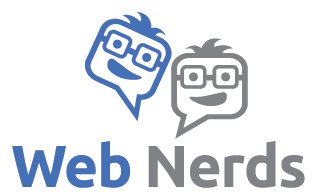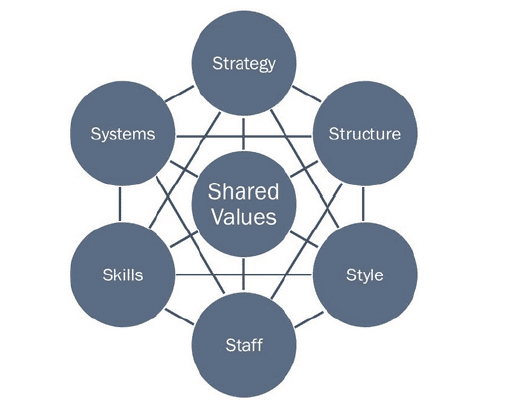An example of reviewing your marketing capabilities using the McKinsey 7S framework
The McKinsey 7S model is a useful framework for reviewing an organization’s marketing capabilities from different viewpoints. Developed by Tom Peters and Robert Waterman during their tenure at McKinsey & Company in the 1970s, this model works well in different types of business of all sectors and sizes, although it works best in medium and large businesses.
The 7S model can be used to:
- Review the effectiveness of an organization in its marketing operations.
- Determine how to best realign an organization to support a new strategic direction.
- Assess the changes needed to support digital transformation of an organization.
What are the elements of the McKinsey 7S model?
In summary, the McKinsey 7Ss stand for:
- Strategy: The definition of key approaches for an organization to achieve its goals.
- Structure: The organization of resources within a company into different business groups and teams.
- Systems: Business processes and the technical platforms used to support operations.
- Staff: The type of employees, remuneration packages and how they are attracted and retained.
- Skills: Capabilities to complete different activities.
- Style: The culture of the organization in terms of leadership and interactions between staff and other stakeholders.
- Shared Values: Summarized in a vision and or mission, this is how the organization defines its reason for existing.
These components can be further broken down into ‘hard’ and ‘soft’ elements.
Hard elements: Strategy, Structure, Systems
Hard elements can be easily defined and directly influenced. They are the (often) more tangible elements of a business, like the strategy documents and mission statements that your company uses to inform its decisions. They also include the organizational charts that demonstrate the reporting structure in your business and the systems that you have in place to ensure everything is running smoothly (such as your IT servers and related data storage methods).
Soft elements: Staff, Skills, Style, Shared Values
As hard elements provide the framework of how a company operates, soft elements are the less tangible qualities that a company demonstrates through its work. They are the people that comprise the workforce, the skills they offer, the office culture that evolves from their co-operation with different teams, and the combined outward impression they give the world.
Think of it like this – hard elements answer many ‘what’ questions about a business:
- Strategy: What is the company’s driving strategy?
- Structure: What teams are in place?
- Systems: What formal systems ensure work progresses?
Whereas soft elements answer many ‘who’ and ‘how’ questions about a business:
- Staff: Who comprises the company’s workforce?
- Skills: How skilled are these workers?
- Style: How do organizational leaders inspire their colleagues?
- Shared Values: How does the company demonstrate its core values?
How can I use the McKinsey 7S model?
You can use each of the 7Ss to assess how the capabilities of an organization can be improved as the starting point of creating an action plan. Below are methods of how you can apply the elements of the McKinsey 7S model, using a hypothetical video games company (SmartPixel) as an example.
1. Strategy
What is your overall strategy? Think about what sets your company apart from its competitors and what position you want to hold or carve out in your industry. You should also have a clear idea of who your key customer personas are and how you are going to meet their demands/solve their problems/help them reach their goals.
Example:
- SmartPixel creates smartphone games in a variety of genres (puzzle, platform, action, racing etc.) that emphasize geographically-specific leaderboards.
- Their primary customer persona is casual gamers aged 30-55, with games aimed to be playable between other activities throughout the day.
- These customers are busy throughout the workday, though need short breaks to distract them and prevent ‘burnout’.
- SmartPixel games, therefore, operate local leaderboards that run for 3/6-hour time periods (called ‘bursts’) before refreshing, ensuring that players are rewarded for skilled gameplay and encouraged to play repeatedly (by chaining ‘burst’ participation together).
2. Structure
How is your company divided at an organizational level? What teams are in place, what tasks are they responsible for, and where do these teams crossover? You may find that, as your business grows and you reassess the McKinsey 7S model, that you need to expand your structure to better manage emerging capabilities that were not present when you started the company.
Example:
- SmartPixel is separated into three main teams – Game Design, Artistic Development, and Programming.
- The Game Design team is responsible for each game’s mechanics, story, and overall ‘game feel’, brainstorming an experience that customers will enjoy.
- The Artistic Development team is responsible for the concept, character, background, and texture design behind each game that will capture the customer’s attention.
- The Programming team is responsible for the coding and technical creation of each game, ensuring that the customers enjoys the functionality of the game and plays it repeatedly.
- These teams each hold their own team managers, who report to an overall Producer team (which hold the company’s C-suite positions).
3. Systems
These are the processes, procedures, and information systems that support your business. Authority in organizational systems must be clear, and technical systems must be successfully managed and maintained to facilitate the work of the company’s teams.
Example:
- The Game Design team pitches ideas to the Artistic Development and Programming teams to create an overall game pitch.
- The Producer team will decide, in consultation with each team’s manager, each game’s overall direction before setting a calendar of work.
- Rudimentary game testing is completed in-house, though further testing is outsourced to a market research company for customer feedback.
- On-site servers are maintained by a dedicated team within the Programming team.
4. Staff
This is the breakdown of staff in terms of their background, age, gender, and characteristics. Evaluate the teams you have in place and whether they are operating at optimal capacity as well as if they can facilitate professional growth.
Example:
- Each team is comprised of a variety of demographics, an important quality to maintain as the company grows.
- C-Suite members have a combined 50 years’ experience in games development, meaning customers know games they play are made by gaming veterans.
- Managers are encouraged to build a sense of comradery in their teams through incentivized activities.
- SmartPixel maintains a relationship with a local university and operates an intern programme in the hopes to stimulate passion in video game creation, develop their skills, and potentially bring them into the company on a full-time basis after graduation.
5. Skills
Always be aware of the overall capabilities of teams and the specific skill set of team members. You should know what core competencies team members must demonstrate, as well as what attributes may expand a department’s offering (such as experience in an international market for using an industry-leading piece of technology).
Example:
- SmartPixel encourages the hiring of artists with widely different styles in order to diversify idea generation and push capabilities of the Programming team.
- Game Development team members are frequently sent on training courses to ensure the ideas they bring to their games are in-line with current consumer trends.
- Team managers must maintain a personal development plan with their team members to monitor and develop their skills.
6. Style
This element includes both the way in which key managers behave in achieving the organization’s goals and the cultural style of the organization as a whole. Managers may come to you with ideas or initiatives they believe will benefit their staff, though will use internal resources (time, budget etc.) meaning you will have to decide how much to allocate to them so long as they demonstrate a return on investment.
Example:
- SmartPixel allows for input from all teams during the idea generation and testing phases of their games. Feedback is anonymized to ensure freedom of expression.
- Team members that show passion behind an idea they pitch are encouraged to take greater responsibility during that idea’s development and ‘take ownership’ of that game’s particular creation.
- Resources are made available to the Programming team to experiment with emerging technology, providing they demonstrate that technology’s suitability to SmartPixel’s current offering.
7. Shared Values
The final aspect of the McKinsey 7S model suggests that guiding concepts of the organization should be evident through both its external work and its internal culture. Neglecting your Shared Values puts your company at risk of becoming lost in the crowd of your competition and employees may not feel as personally tied to their roles, leading to decreasing productivity.
Example:
- SmartPixel aims to instil a sense of personality behind each of their games, incorporating advanced game design ideas in as simple and accessible games as possible.
- Games created should use positive re-enforcement and humour to craft a pleasant experience for even the shortest of gaming sessions.
- Winners of gaming bursts should be recognized through our company’s social media channels to encourage a competitive community of players.
- Internally, SmartPixel regularly recognizes accomplishments and innovations from individuals and teams.
- Flexible working hours are available to ensure SmartPixel employees are able to work in a manner that suits them best.




